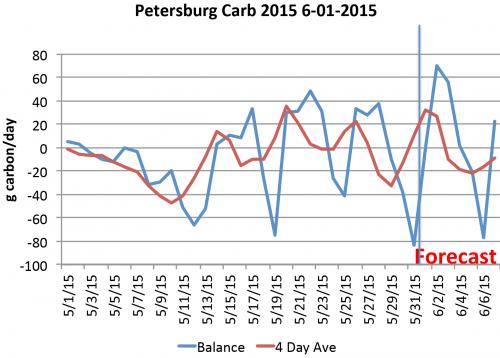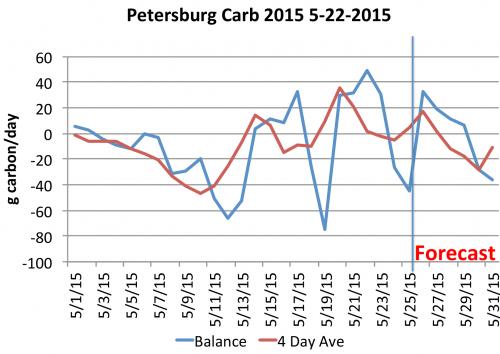Southeast Michigan fruit regional report – June 2, 2015
Much needed rain arrived in the last week for fruit crops, with some growers receiving too little and others too much.
Weather
Rain over the last week throughout southeast Michigan has helped provide much needed soil moisture for our fruit crops. The weekend rain came slow and steady for most growers, allowing it to soak nicely into the ground. Rainfall totals range from 0.5 to 5.1 inches over the weekend, with generally higher totals at fruit farms further south. Soils across the region have adequate moisture levels in the topsoil, but many of our subsoils are still on the dry side. Our seasonal rainfall totals are finally running back toward the normal range.
Warm temperatures last week followed by unseasonably cold temperatures over the weekend brought a mixed bag of growth for our fruit crops. For most of east Michigan, our season is running about normal for growing degree day (GDD) totals as well as growth stages, with the exception for strawberries, which are several days to a week behind normal.
East Michigan GDD totals for March 1 to June 1, 2015 | |||
|---|---|---|---|
|
Location |
GDD42 |
GDD45 |
GDD50 |
|
Commerce (Oakland) |
798 |
647 |
438 |
|
Emmett (St Clair) |
761 |
614 |
414 |
|
Flint (Genesee) |
896 |
734 |
507 |
|
Lapeer (Lapeer) |
833 |
686 |
477 |
|
Petersburg (Monroe) |
889 |
727 |
501 |
|
Pigeon (Huron) |
669 |
539 |
361 |
|
Romeo (Macomb) |
828 |
674 |
456 |
Tree fruits
Apples are mostly 13 to 16 millimeters in size for king bloom, with side bloom running about 2 millimeters less in size. Apple crop load remains mixed and extremely variable across the region this season. Most blocks had great bloom, however now with a poor fruit set. I believe we did not have good bee activity during bloom and some growers also experienced poor weather.
Apple thinning decisions were and continue to be very difficult. Growers need to do a thorough job of scouting apple blocks to help determine crop load. Some growers are planning on thinning later today, June 2, or tomorrow as we have a warmer weather forecast. We are entering an excellent time to apply thinners over the next few days. This will be the last shot at thinning for most apple growers as apples are getting out of the range of thinning. The carbohydrate thinning model and charts suggest trees will not be under stress for this period, so use normal rates and good thinning should occur. In blocks where aggressive thinning needs to occur, use aggressive or higher rates.

The Cornell Carbohydrate Thinning Model for Petersburg, Michigan, as of June 2, 2015.

Summary of all the carbohydrate thinning models for the 2015 season in Petersburg, Michigan.
Apple scab lesions continue to show up in many apple blocks, mostly on leaves and just a bit on fruit. The number of spores released in wetting or rain events over the weekend continues to decline, but we are still in primary apple scab season. According to the MSU Enviro-weather apple scab maturity model, we are at 100 percent of spores being mature. However, remember that once they are mature, we still need wetting events to be released. As of last Wednesday, May 27, I started to see a few fire blight strikes in a few apple blocks. I have not found any oozing from last season’s cankers. Michigan State University Extension advises growers to inspect fire blight-sensitive varieties closely for infections and remove infected limbs as soon as possible. I am just starting to see orange leaf spots from cedar apple rust in a few apple blocks.
Plum curculio stings continue to be found, but all the egglaying scars appear to be old and not fresh stings. I believe while this pest may still be present in all tree fruits, it is no longer doing damage. Codling moth trap catches are on the decline for the first generation flight. Many growers biofixed for codling moth May 19 or 20. Oriental fruit moth trap catch is also on the decline. Rosy apple aphids, green apple aphids and apple grain aphids are being seen in very low numbers. A few potato leafhopper adults and tarnished plant bugs continue to be seen. Oystershell scale crawlers continue in the crawler stage, but are starting to wax over. San Jose scale adult males continue to be caught in traps in high numbers, no crawlers are being found yet. Most of the blocks that had high populations of leafrollers a few weeks ago now have them under control. European red mite egg hatch continues, as are a few rust mites. Many beneficial insects are being seen this week, including mullein bugs and lacewings being found in good numbers in some apple blocks.
Pears are 12 to 16 millimeters in size with larger fruit now starting to grow considerable faster. Much of the side bloom will likely drop. Pear crop load appears extremely variable this season. All stages of pear psylla continue to be seen this week.
Peaches are 12 to 18 millimeters for those few growers with a crop. Growers continue to remove dead and dying trees; most of these blocks are older trees. Tarnished plant bugs are being found in higher numbers this week. There is a fair amount of oozing on trunks and scaffold limbs from winter injury.
Sweet cherries are 13 to 15 millimeters in size, some just starting pit hardening. Some varieties are starting to turn a straw color. This straw-colored fruit may be prone to drop early. Some growers have seen a fair amount of fruit drop in the past week. Most varieties have thinned down to one to three fruit per cluster. Cherry leaf spot is of prime concern at this time as new leaves continue to emerge.
Tart cherries are 10 to 12 millimeters in size. Earlier this season it appeared we had a good crop of tart cherries coming along, but we have had a good amount of fruit drop. Cherry leaf spot is of prime concern at this time as new leaves continue to emerge.
European plums are 12 to 14 millimeters and Japanese plums are 6 to 15 millimeters. Some Japanese plum varieties have little to no crop this season.
Small fruits
Grape shoots are 24 to 30 inches in length for Concord types with flower buds continuing to elongate. Bloom is expected next week. Many European varieties have extensive winter kill and growers have either pruned them back to just above the bud or pulled out entirely.
Strawberries are mostly at small green fruit to thimble-sized fruit, except late flowering varieties that are at full bloom to early petal fall. It appears the start of strawberry harvest will be a several days to a week later than normal. Tarnished plant bugs are being seen in higher numbers this week at a few farms. Gray mold cover sprays are being applied this week as a result of heavy rains at some farms over the weekend.
Raspberries are at full bloom for early flowering summer varieties. Dead cane tips continue to be seen in several varieties of summer fruiting raspberries; these dead cane tips should be pruned at this time. Fall red raspberry canes continue to put on good new growth with the longest canes being 24 to 30 inches in length.
Blueberries have small green fruit, the largest are 10 millimeters in size. Many blueberry varieties do not have good leaf growth this season.



 Print
Print Email
Email


